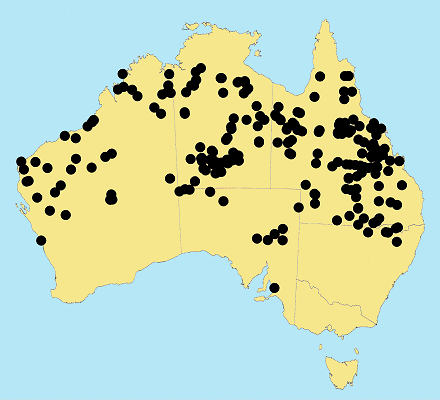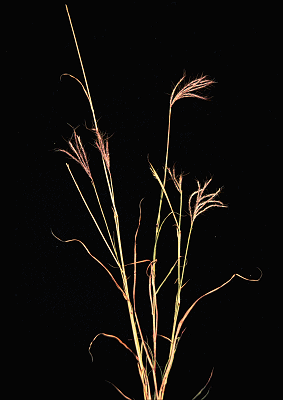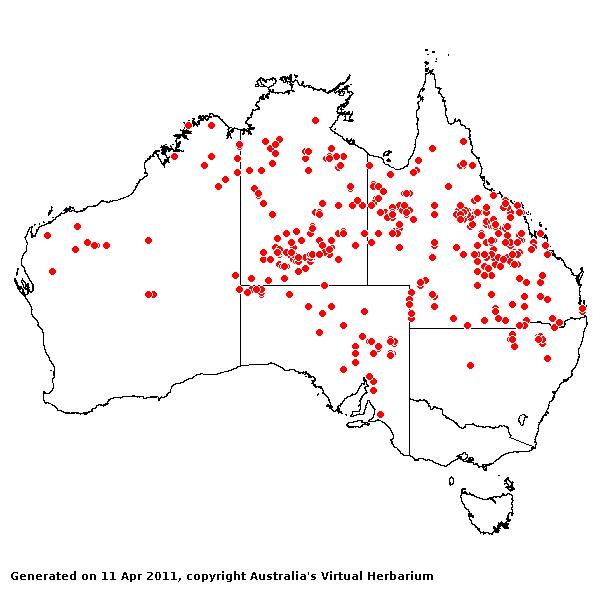Bothriochloa ewartiana (Domin) C. E. Hubbard. Bull. Misc. Inform. 444 (1934).
Classification. (GPWG 2001) : Subfamily Panicoideae. Micraireae.
Basionym and/or Replacement Name: Andropogon ewartianus Domin, Biblioth. Bot. 85: 269 (1915).
Type of Basionym or Protologue Information: "West-Queensland: Grastriften bei Hughenden ...", Domin, II. 1910.
Key references (books and floras): [1952] C.A.Gardner, Flora of Western Australia 1 Gramineae (328 as Dichanthium), [1981] M.Lazarides in J.Jessop (ed)., Flora of Central Australia (487), [2002] D.Sharp & B.K.Simon, AusGrass, Grasses of Australia, [2006] J.Jessop, G.R.M.Dashorst, F.M.James, Grasses of South Australia (509), [2008] S.W.L.Jacobs, R.D.B.Walley & D.J.B.Wheeler, Grasses of New South Wales (169).
Illustrations: [1952] C.A.Gardner, Flora of Western Australia 1 Gramineae (329, Pl.96 as Dichanthium), [1983] J.C.Tothill & J.B.Hacker, Grasses of Southern Queensland (128(5)), [2006] J.Jessop, G.R.M.Dashorst, F.M.James, Grasses of South Australia (511, Fig. 437), [2008] S.W.L.Jacobs, R.D.B.Whalley & D.J.B.Wheeler, Grasses of New South Wales, 4th edn (169).
Habit. Perennial. Culms erect or geniculately ascending, 30–60 cm tall, 6–9 -noded. Lateral branches simple or sparsely branched or branched. Leaf-sheaths glabrous on surface. Ligule a fringed membrane, a ciliolate membrane, truncate. Leaf-blades flat or conduplicate or revolute, 7–15 cm long, 3–6 mm wide. Leaf-blade surface glabrous or indumented.
Inflorescence. Inflorescence subdigitate, with ramose branches. Racemes 3.5–7 cm long. Central inflorescence axis 1–2.5 cm long. Rhachis fragile at the nodes.
Spikelets. Spikelets sessile, 1 in the cluster. Companion spikelets pedicelled, 1 in the cluster. Companion spikelets developed, containing empty lemmas or male, 3.5–4.5 mm long. Fertile spikelets 2-flowered, the lower floret barren (rarely male), the upper fertile, comprising 1 basal sterile florets, comprising 1 fertile floret(s), without rachilla extension, elliptic or oblong or oblanceolate, dorsally compressed, 3.5–4.5 mm long.
Glumes. Glumes dissimilar, firmer than fertile lemma. Lower glume elliptic, chartaceous, without keels, 9–11 -nerved. Lower glume surface indumented. Upper glume lanceolate, keeled, 1-keeled. Florets. Basal sterile florets 1, barren, without significant palea. Lemma of lower sterile floret 66 % of length of spikelet, hyaline.
Fertile lemma without keel. Lemma apex entire, awned, 1 -awned. Median (principal) awn apical, 17–25 mm long overall, with a twisted column. Palea absent. Anthers 3. Grain 2.5 mm long.
Continental Distribution: Australasia.
Australian Distribution: Western Australia, Northern Territory, South Australia, Queensland, New South Wales.
Western Australia: Gardner, Fitzgerald, Dampier. Canning, Giles, Fortescue, Ashburton, Carnarvon, Austin. Northern Territory: Victoria River, Barkly Tableland, Central Australia North, Central Australia South. South Australia: North-western, Lake Eyre, Gairdner-Torrens Basin, Flinders Ranges. Queensland: Burke, Cook, Darling Downs, Gregory North, Leichhardt, Maranoa, Mitchell, North Kennedy, Port Curtis, South Kennedy, Warrego, Gregory South. New South Wales: North-Western Plains.
Notes. A valuable drought resistant fodder grass of the drier grasslands and Eucalyptus forests. Flowers all year.




